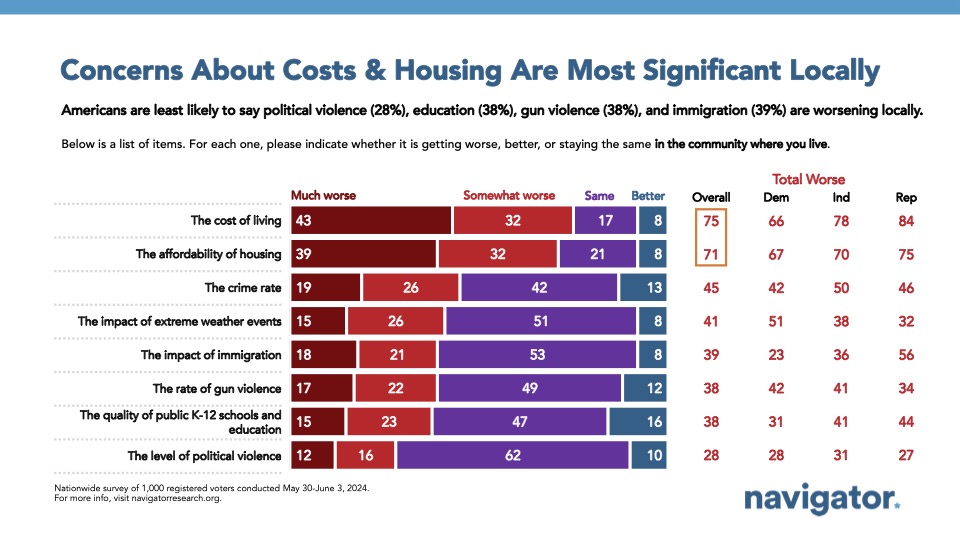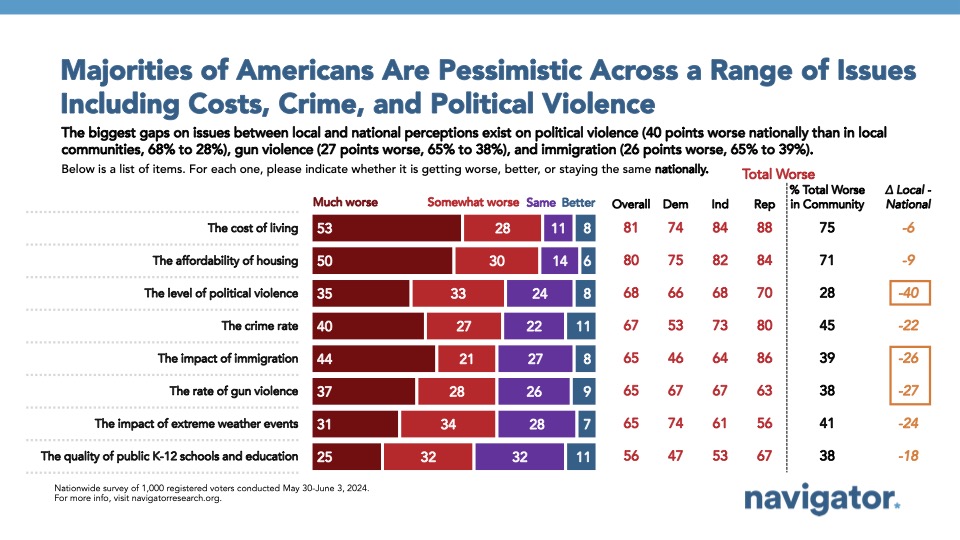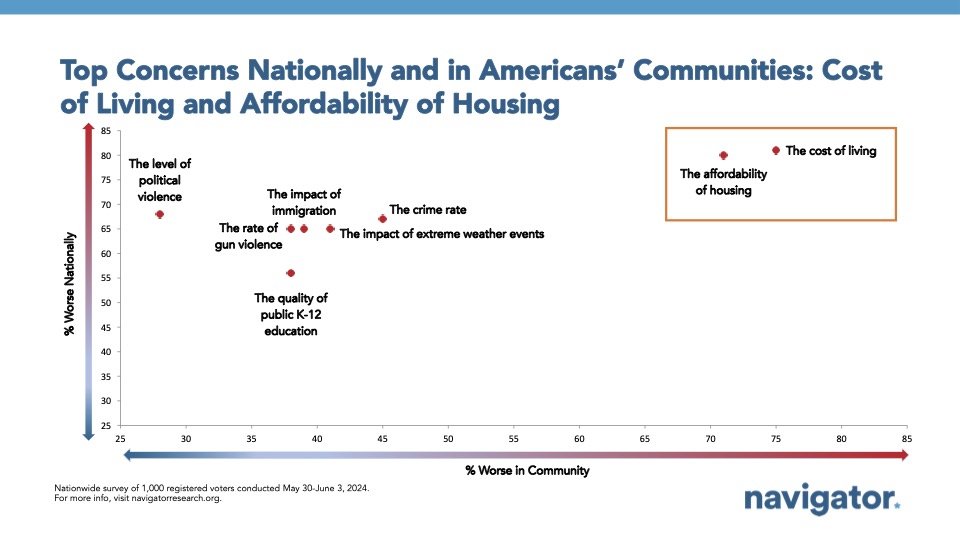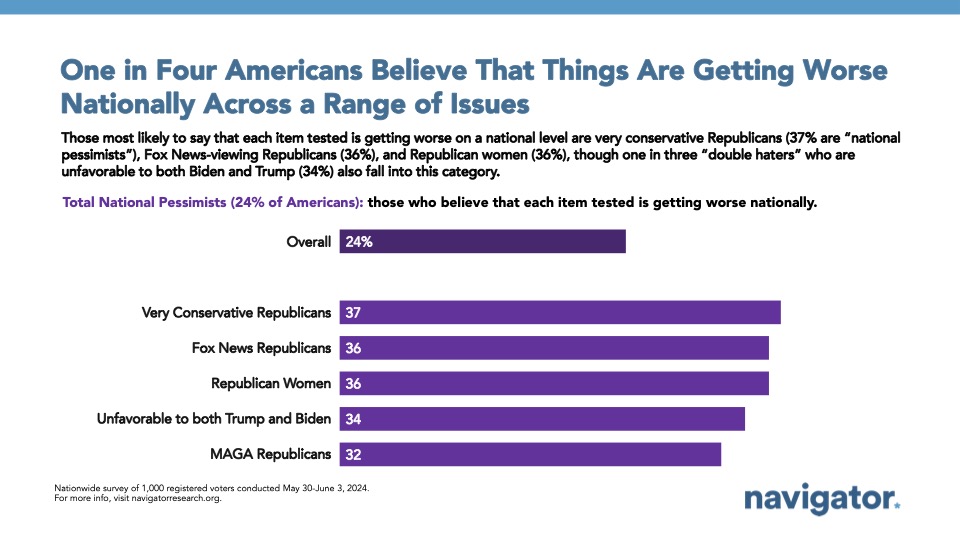Poll: Local vs. National Issues
This Navigator Research report contains polling data on the latest perceptions of issues facing the United States both locally and nationally, including which issues are seen as getting worse, better, or staying the same.
Americans identify the cost of living and affordability of housing at the top of the list of issues that are getting worse both locally and nationally.
Four in five Americans believe the cost of living is getting worse at a national level (81 percent), including a majority who believe it is getting “much” worse (53 percent). Locally, the cost of living is also widely viewed negatively, with three in four saying the cost of living is getting worse in the community where they live (75 percent). Similarly, four in five Americans believe the affordability of housing is getting worse at a national level (80 percent), while seven in ten say it is getting worse in their communities (71 percent).
- Four in five Americans who work in the service industry believe the cost of living in their communities is getting worse (81 percent), compared to 75 percent of those who work white collar jobs and 72 percent of those who work blue collar jobs.
- Nine in ten Americans who are unfavorable to both President Biden and former President Trump believe the cost of living at the national level is getting worse (89 percent), with 83 percent saying the cost of living in their own communities is getting worse.
Most say issues like political violence and crime are getting worse nationally, but not locally.
While issues like political violence, crime, immigration, gun violence, climate change, and public education are widely viewed as getting worse nationally, fewer than half believe these are worsening in their own communities. Two in three Americans believe political violence (68 percent), the crime rate (67 percent), the impact of immigration (65 percent), the rate of gun violence (65 percent), the impact of extreme weather events (65 percent), and the quality of public K-12 schools and education (56 percent) are getting worse at the national level. However, at the local level, Americans are significantly less likely to say these issues are on a negative trajectory, including 45 percent who say the crime rate is getting worse (22 points lower than the share who say it is getting worse nationally), 41 percent who say the impact of extreme weather events is getting worse (24 points lower than the share who say it is getting worse nationally), 39 percent who say the impact of immigration is getting worse (26 points lower than the share who say it is getting worse nationally), 38 percent who say the rate of gun violence is getting worse (27 points lower than the share who say it is getting worse nationally), and 28 percent who say the quality of public K-12 schools and education is getting worse (40 points lower than the share who say it is getting worse nationally).
- In this survey, about one in four Americans rated all of the issues tested as getting worse (24 percent). These “national pessimists” tend to be more conservative: 37 percent of “very conservative” Republicans, 36 percent of Republicans who regularly watch Fox News, 36 percent of Republican women, and 32 percent of Republicans identifying with the MAGA movement say all of these issues are getting worse nationally. Additionally, 34 percent of those who are unfavorable to both Biden and Trump also fall into this category of “national pessimists.”
About The Study
Global Strategy Group conducted a public opinion survey among a sample of 1,000 registered voters from May 30-June 3, 2024. 100 additional interviews were conducted among Hispanic voters. 75 additional interviews were conducted among Asian American and Pacific Islander voters. 100 additional interviews were conducted among African American voters. 105 additional interviews were conducted among independent voters. 200 additional interviews were conducted among voters ages 18-34. The survey was conducted online, recruiting respondents from an opt-in online panel vendor. Respondents were verified against a voter file and special care was taken to ensure the demographic composition of our sample matched that of the national registered voter population across a variety of demographic variables. The margin of error for the full sample at the 95 percent level of confidence is +/- 3.1 percentage points. The margin for error for subgroups varies and is higher.








